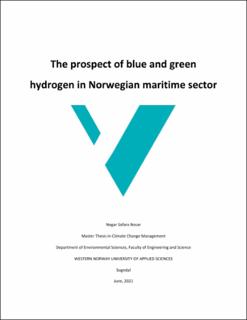| dc.description.abstract | In the face of increasing scientific evidence of the threats of anthropogenic climate change, the maritime sector has become more strictly regulated in recent years. To meet the national and international mandatory environmental obligations, low- and zero-carbon energy solutions need to be developed. Interests in hydrogen as an energy career, among different carbon-lean fuels, have increased in Norway’s low-carbon energy system due to its ubiquity and versatile applications across sectors. As a leader in green shipping, Norway is well-positioned for implementation of hydrogen in maritime industry in terms of natural resources availability, existing compatible infrastructures and technological expertise for the development of hydrogen. However, application of hydrogen technology in Norwegian maritime sectors is at niche level currently. This thesis provides an overview of the established sociotechnical regime as well as focus on the hydrogen niche and their interactions. More specifically, it focuses on the actors, institutions, and the key drivers and barriers influencing the transition pathways. Transition, in general, do not follow a linear process and may follow different pathways affecting by different actors, networks, and mechanisms. As such, the thesis is assessed the implementation of hydrogen technology in Norwegian maritime sector by employing the multi-level perspective (MLP) and the technological innovation system (TIS) approach in conjunction. Taken together the MLP and TIS in the context, it would be possible to discuss the sociotechnical levels (niches, regimes and landscape), their interaction, and their impacts on hydrogen transition in Norwegian maritime industry. In doing so, the TIS was recruited to inform the MLP about the key factors, particularly factors impacting the blue and green hydrogen transformation processes. The findings and analysis show that the hydrogen transition hinges on the lack of knowledge, regulations, and infrastructure at the entire value chain. Hydrogen propulsion vessels may sail on a mix of blue and green hydrogen in the foreseeable future, however blue hydrogen might be the dominant type and could be transported via natural gas pipelines at the initial steps. Overall, blue hydrogen should be viewed as a short-term solution to enable a rapid hydrogen transition while green hydrogen would offer better prospects for a more sustainable economy for Norway. | en_US |

